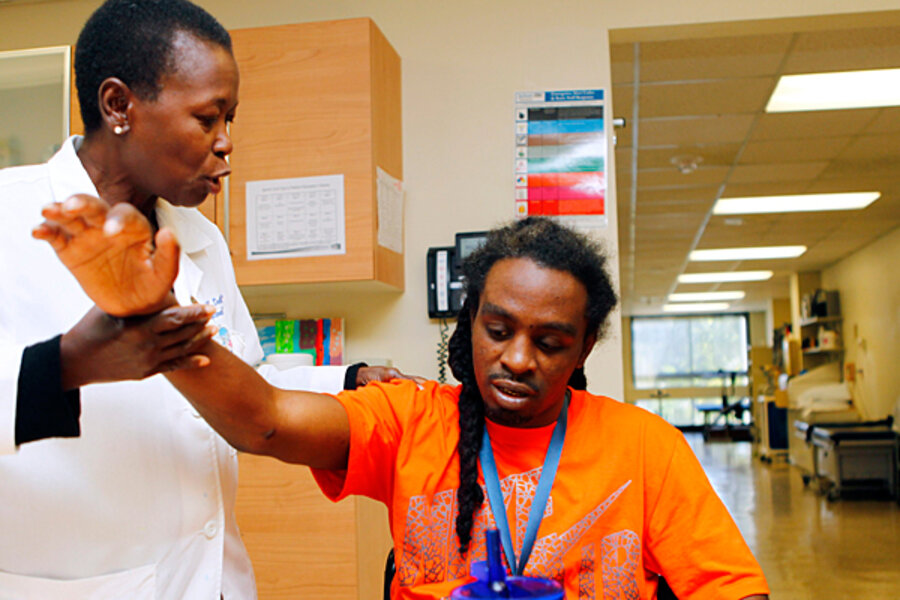Obamacare 101: how the federal subsidy works
Loading...
| Washington
Under the Affordable Care Act, low- and middle-income Americans buying health insurance in the new electronic marketplaces may discover that they are eligible for a federal subsidy.
Here are some questions and answers about the program.
How do I find out if I'm eligible for a subsidy?
Beginning Oct. 1, you can shop for insurance online by going to Healthcare.gov, the federal marketplace, or “exchange.” If your state is one of the 14 (plus the District of Columbia) that has set up its own website, you can go directly to that site. Anyone can also call 1-800-318-2596.
You will be asked to supply basic information, such as your age, your ZIP code, your family size, and your expected income in 2014. If your income falls between 100 percent and 400 percent of the federal poverty level, you will receive a tax credit that can be applied immediately toward your health insurance premium. The tax credit is available only by buying insurance via a government-run marketplace.
If your income is low enough, you may qualify for Medicaid. The ACA provides for an expansion of eligibility for Medicaid, but the US Supreme Court made participation optional, and only 26 states are taking part.
What is the federal poverty level?
In 2013, the federal poverty level is $11,490 for an individual and $23,550 for a family of four. Four times the poverty level amounts to $45,960 for an individual and $94,200 for a family of four. One’s “modified adjusted gross income” (MAGI) is the benchmark; that includes wages, salaries, tips, capital gains, and other income, minus contributions to flexible spending accounts and retirement plans, and certain deductions. This sheet explains exactly what is included in the MAGI.
Does the amount of the tax credit vary with income?
Yes. People living at between 100 and 133 percent of poverty level will pay at most 2 percent of their income for health insurance, while those at between 300 and 400 percent of the poverty level will pay a maximum 9.5 percent of their income. There is a sliding scale for incomes in between, as laid out in the chart in this report.
The cost of the premium is based on the “silver plan” – the second-lowest-cost health plan of four that are offered in each exchange. The silver plan covers 70 percent of health-care costs. The least-expensive plan, bronze, covers 60 percent. The gold plan covers 80 percent, and the platinum plan covers 90 percent.
So how much will insurance end up costing after the subsidy?
That will depend on where you live, how much you make, and which plan you choose. The nonprofit Kaiser Family Foundation presents the example of Pat, who is 45 and will have a 2014 income of $28,735 (250 percent of poverty). The “silver plan” in Pat’s area is expected to cost $5,733. But under the ACA, Pat would pay at most 8.05 percent of income on health insurance, or $2,313 ($192.74 a month). So Pat’s tax credit is $3,420.
What if I can’t afford health insurance, even with the subsidy?
If you still can’t afford insurance, or don’t want to buy it, you can pay a $95 penalty or 1 percent of income in 2014. That penalty will rise to $325 or 2 percent of income in 2015 and to $695 or 2.5 percent in 2016. After that, the increases are indexed to inflation, with a cap.
If I get insurance through work, can I still buy insurance on the exchange?
Yes, but chances are your employer is paying a significant part of your premium, so you are likely getting a better deal at work than you would buying insurance through the exchange, even with the subsidy.
Other articles in our Obamacare 101 series:
• What happens starting Oct. 1?
• What to know if you already have health insurance
• What to know if you opt out of buying health insurance
• What owners of small businesses need to know
• When will the enrollment glitches be fixed?
• What college students need to know
• Seven ways you can sign up, despite Web woes
• Enroll by March 31 to avoid penalty, White House clarifies








